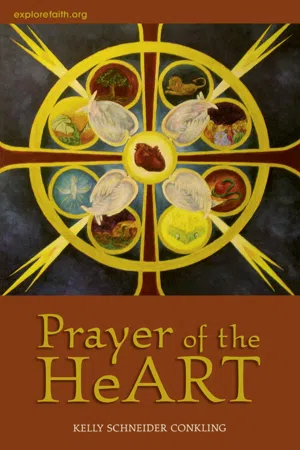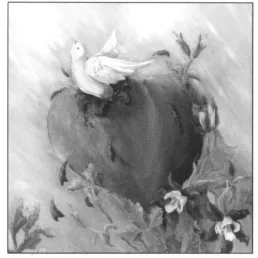![]()
Part 1
Prayer of the heART
![]()
1
— HEART SPIRITUALITY —
Art. Images. Symbols. God. Life. Sacraments. Incarnation. These have always been intrinsically bound together for me. From an early age I saw and sought God through these means, even when I wasn’t aware of what I was doing. Playing on the floor around the altar while my mother and grandmother worked—before I was big enough to help. Later, getting up early on Saturday morning to go out and cut flowers before the day got too hot. Placing them in deep water and taking them to the church to prepare them for the altar. Polishing the brass. Preparing the linens. Setting the altar. Placing the candles just right. Touching the rich purples, greens, reds, and whites of the hangings, soft, smooth, laced with golden threads and tassels. Watching the reflection of colors from the stained glass windows dance across the pews and the floor. Feeling the silence. Sensing the presence of God in that place and in and through the images and symbols all around me.
I am a visual person, somebody who experiences God best through the senses—touching, smelling, hearing, seeing, tasting, and the sacramental experiences of daily life, from flowers to a beautiful work of art, from a cup of tea with my mother to a walk with my husband to sitting on the patio listening to birdsong. Prayer is an integral part of these simple acts of living. It’s an intentional awareness of God in, with, and through all aspects of our lives. And yet, at times prayer can be very elusive—words, ideas, thoughts, and conversations with God that seem to go nowhere, that have no sense of reality. For years I sought forms of prayer that had tangible elements to them. I looked and read and searched many places.
When I was about seven, my grandfather gave me a set of art books that covered the span of human artistic development in every culture. There were twelve books in all with hundreds of images of paintings, drawings, sculpture, and artifacts. I spent many an hour as I grew up looking through these books, over and over again, intrigued by the variety of expression. I remember being drawn in particular to the “religious” art work, both curious and confused by the artist’s ability to represent God or the gods of their culture. I began to realize deep within my soul that there was a deep connection between God, art, and the stirrings of my heart.
My first conscious connection of prayer and art—tangible, visual prayer—came with my discovery of the Scottish minister and author George MacDonald. In his book, Lilith, an adult fairy tale, he writes of a man who is taken to a parallel world. As he and the raven, his guide, are walking through the church cemetery, the raven points out a flower—a prayer flower. After a discussion about how a flower could really be a prayer, the man states, “But I did see that the flower was different from any flower I had ever seen before; therefore I knew that I must be seeing a shadow of the prayer in it; and a great awe came over me to think of the heart listening to the flower.”1 The great Heart listening to one of its little hearts. This concept struck me like a bolt of lightening: The heart of God, in which we live and move and have our being, listens to the longings and groanings of our little hearts.
This is a book about prayer. It’s a book about a method of prayer using visual images as the means through which we allow God to speak with us. Ranier Maria Rilke wrote, “Work of the eyes is done, begin heartwork now on those images in you, those captive ones.”2
Our culture today is in dire need of doing “heartwork.” In the Celtic tradition there’s a clear sense of our having been created in the image and likeness of God and an embracing of all that entails: our innate goodness, our free will, and our responsibility to be co-creators with God in this world today. In what my now grown-up daughter calls our “generic” culture, I’ve found that visual imaging, used as prayer, can help with the “heartwork”—to find that center within ourselves where God dwells and in which we live and move and have our being.
RECOVERING AN ANCIENT WAY OF THINKING
The great Heart listening to its little hearts. The heart of God listening to the hearts of God’s children. When I was in seminary, I discovered an affirmation of this connection between the heart and prayer in the writings of a fifth-century Syrian mystic, Pseudo-Macarius. He wrote of our journey to God as a progression of the heart—a progression from a heart that was sinful, to a heart infused by grace, and finally to a heart that totally belonged to God. This heart spirituality of Macarius is based in the ancient Hebrew understanding of heart, which influenced all of the Old and New Testaments and continued for many centuries in the Christian Church.
One of the striking things about the Judeo-Christian concept of God is that our God is a God with a heart. In turn, this God of ours, in whose image we are created, has given us a heart. The ancient understanding of “heart” is one that is multi-dimensional. The heart is the place of our emotions and affections. It is the place of thinking and wisdom, the place where our free will and conscience reside. In this way, the heart specifically refers to the human person as a whole. The heart is the core of our being, our inner self, and, most importantly, it is the place where we come face to face with God. It is the place where the Spirit of God is active.
It is this rich understanding of the heart that Macarius had in mind when he attempted to explain the workings of the heart in relationship to prayer. He wrote:
The heart itself is but a small vessel, yet dragons are there,
and there are also lions; there are poisonous beasts
and all the treasures of evil. There also are rough and uneven
roads; there are precipices. But there too is God, the angels,
the life and the Kingdom, the light and the apostles
the heavenly cities and the treasures of grace—all things
are there.3
During the 1990s I saw a movie called Restoration. Set in England during the seventeenth century, it was about the life of a doctor. In one memorable scene, the doctor and his friend see a man who had come to the hospital with a kind of leather shield over his chest. They gather around, and he unbuckles the shield opening the front flap. Beneath the shield his chest is open—open and red like a wound, but open as if it had grown that way, with his beating heart clearly visible. The doctor and his friend, of course, are amazed. The man with the open chest asks if the friend wants to touch his heart. Enthralled and fascinated, he’s also afraid and can not bring himself to. The man then invites the doctor, who slowly steps up and tentatively reaches out to touch the heart; a smile of joy, amazement, and understanding spreading over his face at the moment of contact.
In the seventeenth century, William Harvey, an English doctor, actually did present to his colleagues at the Royal College of Physicians a visible, tangible heart, one that could be held in the hand, measured, and dissected.4 At this moment, the heart became “demythologized.” As James Hillman wrote in The Thought of the Heart and the Soul of the World, “Thought lost its heart, heart its thought.”5 Human beings’ love affair with scientific proof pushed away the heart of the past. Emphasis was placed on the “real” heart rather than the “symbolic” heart. Now when the heart was spoken of, it was the physical muscle in the breast. Any ancient understanding was relegated to metaphorical sayings like “wearing his heart on his sleeve.” From this point on, the divide between heart and mind, heart and emotions, has continued to grow.
The heart is literally a muscle, an organ in our body, which pumps blood. But is that all there is to the heart, or were the ancient Hebrews on to something? Today we are now beginning to see that this “pump in the chest” isn’t all there is to it. Recently scientists in the field of neurocardiology have discovered that the heart has its own nervous system that functions independently from the brain. Simply stated, it receives and sends information to the brain that creates a two-way communication between the two organs.6 The heart and brain “talk” to each other. The heart sends feelings and emotions to the brain, which in turn affect our health and well-being. So the metaphor of the heart by Macarius is really quite accurate. As we begin to recover an old way of looking at the “seat of our emotions,” we find that there are deeper levels of “truth” than there are in cold, rational biology alone. “The heart, as the innermost spring of human personality is directly open to God and subject to his influence.”7 Indeed, as we read in Psalm 33:15, God “fashions the hearts of them all.”
In seeking to recover Heart Spirituality, we’re connecting ourselves to the very core of our being. It’s the path, the way, which Jesus taught—a way of living into and existing within the heart of God. As Meister Eckhart said of God, “You don’t need to seek him here or there. He is not farther off than the door of your heart.”8 In the process of visual prayer and journaling, which focuses on heart spirituality, we can learn a lot about the landscape of our own hearts as Macarius described them, discover deeper truths about ourselves, and make contact with God through ancient ways of prayer, journaling, and art, seeing and exploring them in new ways.
1. George MacDonald, Lilith (Grand Rapids, Mich.: Eerdmans, 1981), 26.
2. Ranier Maria Rilke, “Turning,” in Edward Snow, Uncollected Poems: Ranier Maria Rilke (New York: North Point Press, 1996), 91.
3. George A. Maloney, S. J., ed., Pseudo-Macarius: The Fifty Homilies and The Great Letter (New York: Paulist Press, 1992), 222.
4. Gail Godwin, Heart: A Natural History of the Heart-Filled Life (New York: Perrenial, 2002), 112.
5. James Hillman, quoted in ibid., 113.
6. The Inside Story: Understanding the Power of Feelings (Boulder Creek, Calif.: Institute of HeartMath, 2002), 23.
7. The Interpreters Dictionary of the Bible, Vol. E-J (New York: Abingdon Press, 1962), 550.
8. Meister Eckhart, Breakthrough: Meister Eckharf’s Creation Spirituality in New Translation (New York: Doubleday, 1980), 242.
![]()
2
— HEART AS PRAYER —
It was late in the evening. It had been one of those days—the kind of day when you find yourself anxiously awaiting the moment you get all of your work and chores done and can finally get to bed for...




